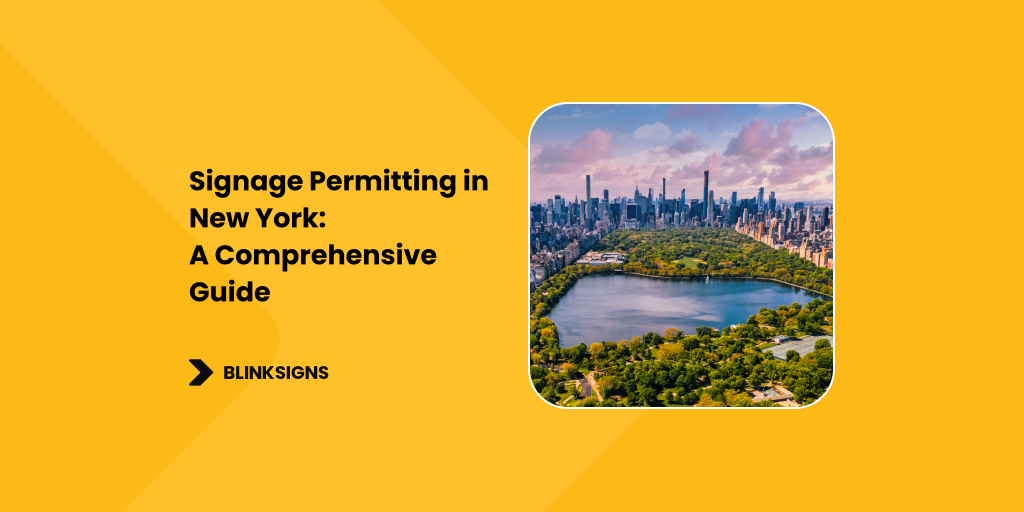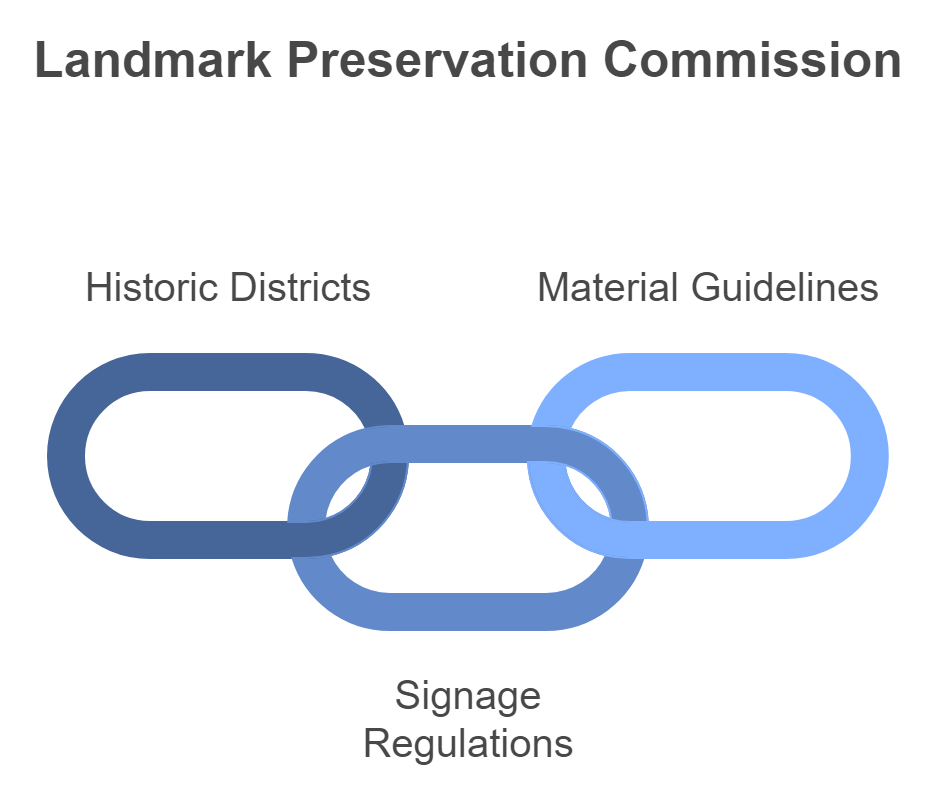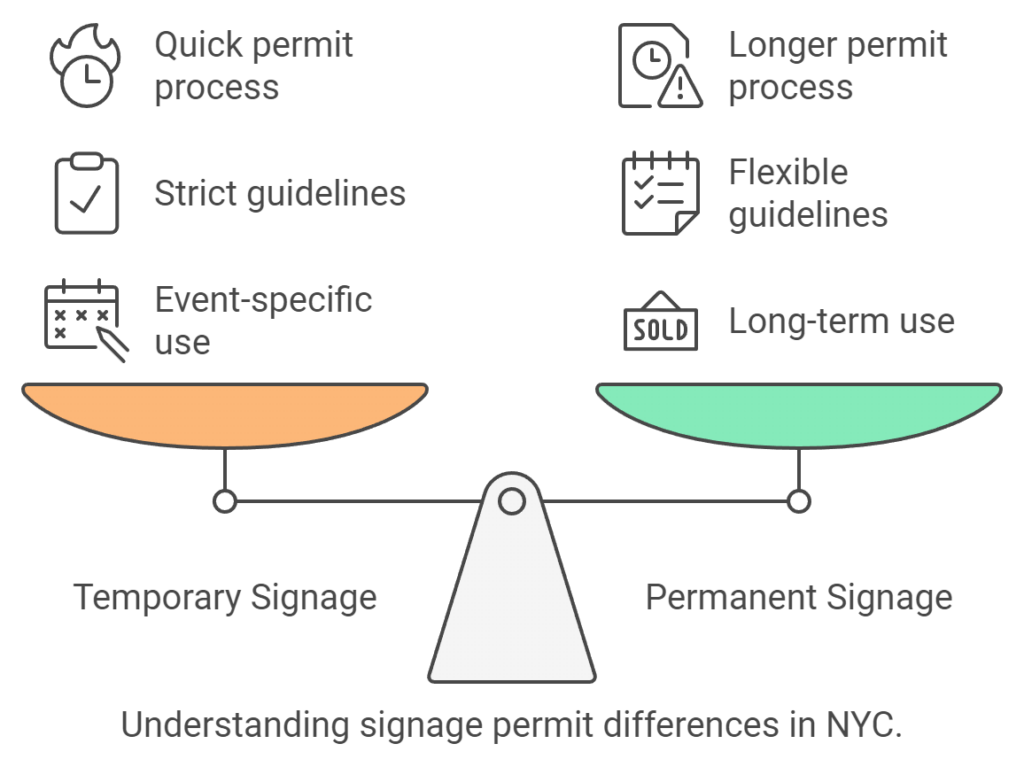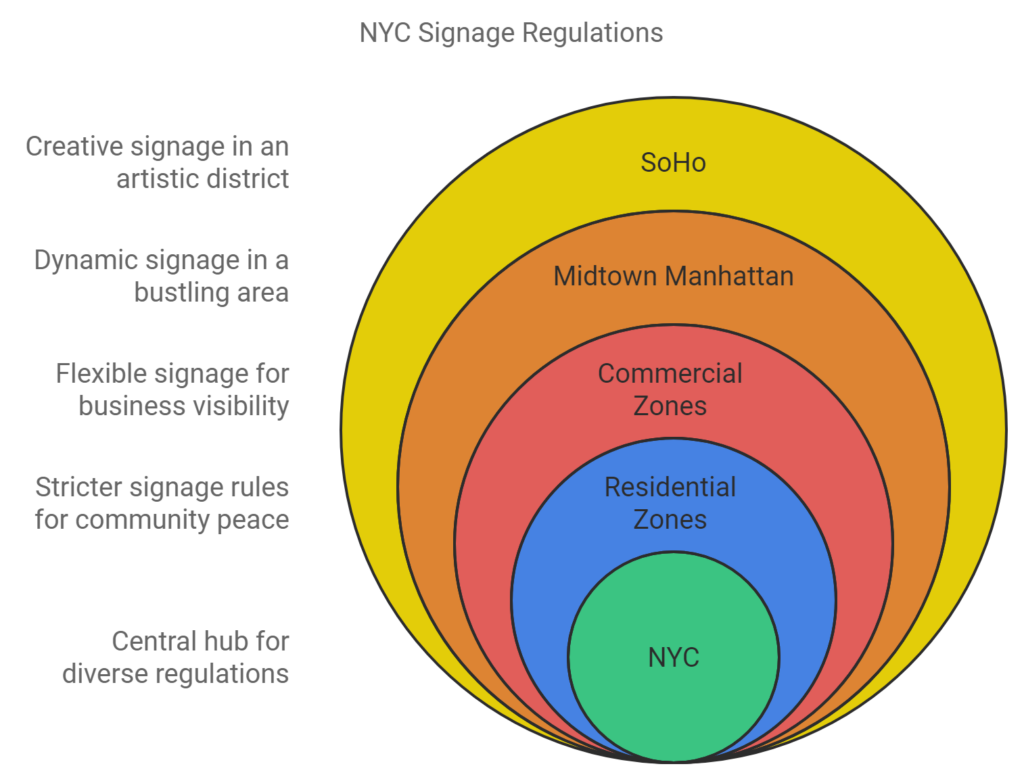
Signage Permitting in New York: A Comprehensive Guide
Getting signage approved in New York City can feel like an uphill battle. Complex zoning laws, multiple permits, and strict regulations often lead to delays that can hurt your business. But this doesn’t have to be your struggle. At BlinkSigns, we take the headache out of the permit process. We know how frustrating it is to navigate the city’s red tape and how costly delays can be. That’s why we manage every step—from zoning compliance to installation—so your business signage gets approved faster, with no surprises.
Trust BlinkSigns to handle the details so you can stay focused on growing your business without the stress of permits holding you back. Let us guide you through the process with more information.
Understanding the New York City Department of Buildings (DOB) Role in Signage Permitting
The New York City Department of Buildings (DOB) is the central authority regulating signage across New York. This department ensures that all signage meets the city’s structural, safety, and zoning requirements. The DOB reviews applications for new signage installations and modifications to existing signage, ensuring they meet the city’s strict building codes. These regulations focus on safety aspects, such as wind load capacity, material durability, and overall structural integrity, ensuring that signs do not pose hazards to the public.
When applying for signage permitting in New York, businesses must submit detailed plans, including design specifications, site location maps, and installation blueprints. Electrical plans must also be included for illuminated signs. At BlinkSigns, we assist you throughout this process by preparing error-free applications and navigating the regulatory maze to avoid unnecessary delays or rejections.
Navigating the NYC Zoning Resolution for Signage Approval
The NYC Zoning Resolution dictates where businesses can install signs, the type of signage allowed, and how large and bright those signs can be. Zoning laws are designed to control the aesthetics and functionality of neighborhoods. For example, large digital signs are permissible in commercial hubs like Times Square, whereas residential zones strictly regulate the size and type of signage to maintain neighborhood integrity.
Every district in New York City has its own zoning regulations, which may include restrictions on sign height, illumination levels, and placement relative to public streets or landmarks. Understanding your business location’s zoning classification is essential for ensuring compliance. BlinkSigns helps businesses navigate these zoning complexities, ensuring their signs align with local laws while maintaining their desired visual impact.
The Landmark Preservation Commission: Special Considerations for Historic Districts
The Landmark Preservation Commission (LPC) protects New York’s historic districts, such as SoHo, Tribeca, and Greenwich Village. Businesses in these areas face stricter signage regulations, as the LPC ensures that all new signage aligns with the neighborhood’s historic character. This often means using traditional materials like wood, stone, or iron and avoiding modern, out-of-place elements such as neon or LED lighting.

Landmark Preservation Commission NYC explained
Businesses must submit detailed designs that respect the area’s architectural integrity to secure approval from the LPC. The approval process may take longer due to multiple design review and revision rounds. BlinkSigns works closely with the LPC to ensure your signage complements the surrounding historic buildings and complies with all legal requirements, streamlining the approval process.
Key Requirements Under the NYC Sign Code
The NYC Sign Code establishes apparent sign size, placement, and illumination guidelines. Every business must adhere to these regulations to avoid penalties. Signs must comply with maximum height and size restrictions based on the zoning district, and illuminated signs must meet strict light pollution standards. Additionally, the Sign Code differentiates between temporary and permanent signs.
Permanent signs require detailed structural and safety reviews, particularly if they are illuminated or digitally enhanced. Temporary signs, often used for events or promotions, have time limits and must be removed promptly after their designated use period. BlinkSigns ensures that all signage meets the NYC Sign Code requirements, avoiding potential violations and ensuring seamless approval.
Comprehensive Overview of NYC Signage Permit Requirements
| Permit Type | Required Documents | Key Regulations | Approval Timeline | Inspections Required |
| Permanent Sign Permit | – Detailed design plans
– Structural blueprints – Electrical schematics (if illuminated) – Zoning approval |
– Must meet NYC Building Code for structural safety
– Zoning regulations (height, size, and placement) – Light pollution control for illuminated signs |
2 to 6 months | – Structural safety inspection post-installation
– Electrical inspection for illuminated signs |
| Temporary Sign Permit | – Event details
– Design plans with dimensions – Removal timeline – Site plan |
– Must comply with time limits (typically 30–90 days)
– Strict size and placement guidelines – Must be removed after the event |
1 to 3 weeks | – No structural inspection required
– Removal deadline enforcement inspection |
| Illuminated Sign Permit | – Electrical schematics
– Brightness control plans – Zoning approval – Light pollution mitigation strategy |
– Must comply with NYC light pollution laws
– Brightness limits at night – Electrical safety standards |
3 to 6 months | – Electrical inspection required
– Light pollution assessment at night |
| Public Right-of-Way Permit | – Projection dimensions
– DOT clearance for sidewalk encroachment – Pedestrian safety plan – Height clearance details |
– Must comply with DOT rules for public safety (blade signs, awnings, A-frame signs)
– Height and projection restrictions to prevent obstruction |
1 to 2 months | – DOT inspection for encroachment
– Regular pedestrian safety checks |
| Master Signage Program | – Unified signage plan for multi-site or large developments
– Detailed designs for all signs – Compliance with zoning laws for all locations |
– Ensures cohesive design across large properties
– Streamlines approval for multiple signs at once – Must meet zoning and safety codes for all included sites |
Varies depending on the size of the development
– Typically 3 to 9 months |
– Site inspections at multiple stages across all included locations
– Electrical and structural checks for illuminated and freestanding signs |
| Variance/Conditional Use Permit | – Justification for variance
– Public hearing documentation (if required) – Zoning compliance documentation – Impact analysis |
– Allows signage that exceeds standard zoning limits (height, size, or lighting)
– Public hearings may be required for variances in sensitive areas – Detailed impact assessment necessary |
3 to 9 months, longer for complex projects | – Post-installation inspections based on approved variance conditions (size, illumination, placement) |
Unique Signage Regulations for Times Square
Times Square is globally renowned for its massive, illuminated digital billboards, but it is also one of the most tightly regulated areas in New York regarding signage. The city imposes strict brightness, size, and content rules to maintain safety and visual harmony in this high-traffic area. All signs in Times Square must adhere to specific brightness limits to prevent glare and visual distraction for drivers and pedestrians.
Additionally, there are content restrictions to ensure advertisements are appropriate for a diverse, family-oriented audience. BlinkSigns helps businesses manage their signage projects in Times Square, ensuring they maximize impact without running afoul of the local rules. Our team ensures your signage is fully compliant while capturing the attention of the millions of people passing through this iconic location daily.
Applying for Temporary vs. Permanent Signage Permits in New York
New York City distinguishes between temporary and permanent signage permits, and understanding the differences is crucial for businesses. Temporary signage, often used for events, sales promotions, or special occasions, must adhere to strict guidelines and be limited in size, duration, and placement. The permit process is quicker for temporary signs, but significant penalties exist for failing to remove them on time.

Understanding signage permit difference in NYC
Permanent signage requires a more thorough application process and extensive review by the DOB, especially if the sign is illuminated or digital. Structural integrity, lighting control, and zoning compliance are essential aspects of the review process for permanent signage. BlinkSigns manages temporary and permanent signage permits, ensuring you meet all regulatory requirements.
Environmental and Structural Safety Compliance for Outdoor Signs
New York City’s strict environmental and structural safety requirements ensure that all outdoor signage is safe for pedestrians and vehicles. These regulations focus on preventing accidents caused by improperly installed signs, particularly in high-traffic areas. Signage must withstand wind loads, rain, and snow without posing a risk to public safety.
Additionally, illuminated signs must comply with light pollution standards to prevent excess brightness from disturbing nearby residents. Signs must also adhere to specific building codes for structural integrity to remain securely attached to supporting structures. BlinkSigns ensures that all outdoor signage complies with New York’s safety standards, preventing costly fines and ensuring long-term durability.
Public Right-of-Way Signage: Permits for Blade, A-frame, and Awning Signs
Signs that project into public spaces, such as blade signs, A-frame signs, and awning signs, require additional permits from the NYC Department of Transportation (DOT). These signs must comply with projection limits and height restrictions to ensure they do not obstruct pedestrian traffic or pose safety risks. Blade signs, for instance, must be installed at a height that prevents collisions with pedestrians while maintaining visual appeal.
Awning signs and A-frame signs must also adhere to guidelines regarding size and placement on sidewalks. These permits require detailed design submissions and may involve additional inspections to ensure public safety. BlinkSigns navigates the permit process for public-facing signs, ensuring your business complies with DOT regulations while enhancing its street presence.
The Role of the NYC Department of Transportation in Signage Approval
The NYC Department of Transportation (DOT) approves signs extending into public streets or sidewalks, such as awning and blade signs. The DOT’s main priority is ensuring public safety, meaning that businesses must submit detailed design plans outlining how their signage will interact with pedestrian and vehicle traffic.
DOT regulations cover sign height, projection limits, and pedestrian clearance. Blade and awning signs must be installed at specific heights to avoid obstructing foot traffic. Additionally, A-frame signs must be carefully placed to prevent sidewalk blockage. BlinkSigns handles the entire DOT approval process, ensuring that your signage adheres to all safety standards while maximizing visibility.
Commercial vs. Residential Signage: What You Need to Know
Signage regulations vary significantly between commercial and residential zones in New York City. Commercial areas, particularly in districts like Midtown Manhattan or SoHo, allow for more extensive, illuminated signs. These signs can be more complex and dynamic, incorporating digital displays or bright lighting, provided they meet zoning requirements. However, stricter rules apply in residential areas to ensure the signage does not disturb the local community.

NYC Signage Regulations Explained
In residential zones, signs must be minor, non-illuminated, and placed to preserve the neighborhood’s aesthetic character. Businesses operating in mixed-use areas must carefully navigate these regulations to avoid violations. BlinkSigns ensures that your signage meets the appropriate rules for your zone, balancing compliance with impactful design.
Historic Districts: Adhering to Special Signage Guidelines in New York’s Heritage Areas
New York City’s historic districts, like Tribeca, Alamo Square, and Greenwich Village, have specific guidelines to preserve their aesthetic integrity. The Landmark Preservation Commission (LPC) is the leading authority regulating new signage in these districts. Businesses within these areas must submit designs that align with the neighborhood’s architectural heritage. Modern materials, like neon and LED, are often restricted or completely prohibited in favor of traditional materials like wood, iron, or stone.
The signage approval process for businesses in these districts involves additional reviews and longer timelines. The LPC works closely with companies to ensure that any new signage blends seamlessly with the historic surroundings while still being functional. BlinkSigns helps businesses develop signage plans that meet LPC standards while maintaining a modern, engaging appeal for customers.
Digital Billboards and LED Signs: NYC Restrictions and Opportunities
While digital billboards and LED signs offer dynamic marketing opportunities for businesses in New York City, they come with stringent regulations, particularly in residential zones and historic districts. In commercial districts like Times Square, companies can leverage large digital displays to attract attention, but these signs must adhere to strict guidelines on brightness, content transitions, and timing.
Digital billboards are required to reduce light pollution and may need to dim during nighttime hours to avoid disrupting nearby residents. Additionally, signs in mixed-use or residential areas may have restrictions that limit animation or the frequency of content changes. BlinkSigns ensures businesses take full advantage of digital signage opportunities while complying with the city’s rigorous standards.
Filing Fees and Inspection Processes for NYC Signage Permits
When applying for a signage permit in New York, businesses must account for filing fees and a series of mandatory inspections. Filing fees vary based on the signage’s size, type, and location. For example, permits for illuminated signs or large digital displays typically come with higher filing fees due to the complexity of installation and more significant impact on public spaces.
In addition to filing fees, businesses must undergo several inspections throughout the signage installation process. These inspections ensure that the sign meets all structural safety and environmental standards. At BlinkSigns, we manage the full spectrum of the permit process, from paying filing fees to scheduling inspections, ensuring that all requirements are met before installation begins.
Variances and Conditional Use Permits for Signage That Exceeds Zoning Regulations
Sometimes, businesses may want to install signage that exceeds the restrictions set by local zoning laws. Companies must apply for a variance or Conditional Use Permit (CUP) in these cases. Under specific conditions, these permits allow businesses to deviate from standard regulations, such as height limits, sign size, or illumination levels.
Applying for a variance can be lengthy and may require public hearings, especially in residential or mixed-use areas where neighborhood impact is a concern. BlinkSigns helps businesses prepare and submit the necessary paperwork for variance requests, ensuring their companies get the signage they need without violating zoning laws.
Compliance with Light Pollution and Noise Ordinances for Illuminated Signs
New York City enforces strict light pollution and noise regulations to protect residents, particularly in areas close to residential buildings. Illuminated signs, especially those using LED technology, must be carefully designed to avoid excessive brightness and glare, which could disrupt nearby homes and businesses. Many districts have ordinances that require illuminated signs to dim or turn off during specific hours to minimize their impact on the surrounding community.
Additionally, noise ordinances apply to signs that emit sound, such as those incorporating audio or video displays. BlinkSigns ensures that illuminated and digital signs comply with all light and noise regulations, helping businesses maintain visibility without causing disturbances.
Master Signage Programs for Large Developments in New York
For businesses operating across large properties or multiple buildings, a Master Signage Program can help streamline the approval process. This program allows companies to submit a comprehensive signage plan for an entire development, ensuring that all signs are cohesive regarding design, placement, and compliance with local laws.
Master Signage Programs are particularly useful for significant commercial developments, shopping centers, or campuses that require multiple signs in various locations. With a unified signage plan, businesses can expedite approval while ensuring consistent branding across all locations. BlinkSigns specializes in developing Master Signage Programs that meet the complex needs of large developments, ensuring compliance and aesthetic unity.
Special Advertising Restrictions Near Schools and Parks
New York City imposes strict restrictions on advertising near sensitive areas such as schools and parks. These areas are protected from aggressive advertising to preserve a family-friendly environment. Businesses near these locations must follow sign size, content, and placement regulations to avoid violating city ordinances.
For instance, billboards and digital displays near schools must not feature content that is deemed inappropriate for children. Additionally, nearby signage’s brightness and noise levels must be carefully controlled. BlinkSigns helps businesses in these areas create compliant signage that promotes their brand without violating city regulations.
Maintaining and Renewing Signage Permits in New York
Once a signage permit is approved, businesses must ensure that the signage complies with city regulations over time. Some licenses, especially temporary signs or illuminated displays, require renewal after a certain period. Failing to renew a permit can result in fines or the forced removal of the sign.
Additionally, businesses must maintain their signage to remain structurally sound and visually compliant. Regular inspections may be required to confirm that signs have not deteriorated or become hazardous. BlinkSigns manages permit renewals and maintenance schedules, ensuring businesses remain compliant long after installation.
Public Art and Signage Integration: Navigating Hybrid Installations
In some areas, businesses may want to integrate public art into their signage as part of a hybrid installation. While public art can enhance a business’s connection to the local community, these installations must still comply with New York City’s signage regulations, especially regarding size, placement, and safety standards.
Public art signage must be carefully planned to ensure it does not obstruct public spaces or create pedestrian hazards. BlinkSigns helps businesses integrate public art into their signage while ensuring all installations meet city regulations. This allows companies to showcase creativity and enhance their brand identity while remaining compliant.
Avoiding Common Signage Violations in New York
The state of New York penalizes many businesses for common signage violations, such as exceeding the permitted sign size, not securing permits, or violating zoning regulations. These violations can result in fines, permit rejections, or even the forced removal of the sign.
Installing signs without permits, exceeding height or brightness restrictions, and placing signs in prohibited areas are among the most common violations. BlinkSigns assists businesses in obtaining permits and ensures their signage complies with New York’s strict signage regulations, thereby avoiding costly violations. Check out our latest guide for signage permitting in different cities Navigating the Landscape of Signage Permitting: A Comprehensive Guide
Conclusion
We at BlinkSigns are dedicated to making signage permitting in New York easy for businesses. From zoning research to permit applications, our team ensures your signage complies with city laws and promotes your brand effectively, from zoning research to permit applications.
If you contact us at sales@blinksign.com today, we can help you navigate the complex signage regulations in New York and create impactful, compliant signage for your business.